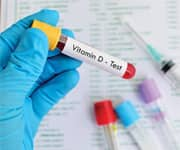Life Extension Magazine®
When most of us first learned about vitamins, we were told one thing about vitamin D: It’s good for our bones.
And it is. But in recent years, scientists have found receptors that respond to vitamin D in nearly every cell in the body.1
There’s a reason for that. We now know that vitamin D is vital for the health of our brain and heart, for protecting against premature aging, and for holding off metabolic disorders like type II diabetes.2-6
One preclinical study even showed that vitamin D increased median lifespan by 33%.7
Researchers have also discovered that lower levels of vitamin D in the body are associated with increased risk for many age-related chronic diseases.5,8-11
In other words, getting enough vitamin D appears critical for nearly every aspect of health.
But a vast majority of adolescents and adults in the U.S. and Europe have dangerously low levels of vitamin D in their blood.12-15 Correcting this deficiency by taking 5,000 IU to 8,000 IU of vitamin D daily could help prevent age-related loss of function and many chronic diseases, and prolong a healthy life.
What’s Behind the Deficiency

In the U.S., 35% of adults are vitamin D-deficient (defined as levels of 25-hydroxyvitamin D less than 20 ng/mL). This rate is even higher in the elderly and other high-risk groups, such as those with darker skin color.16
One of the main reasons is lack of sunlight.
For the body to produce vitamin D, we need direct skin exposure to sunlight. The energy from the sun is the critical ingredient that converts precursor compounds into the biologically active vitamin.
Air pollutants, smoking, and other toxins can interfere with vitamin D metabolism as well, making the problem even worse.17 And as we age, our bodies produce less vitamin D, even though we need more of it.18
Spending more time in the sun raises the risk of skin cancer and accelerated skin aging. But there’s a simple solution: increasing intake of vitamin D to boost our bodily levels.
It’s extremely difficult to get enough from food sources like fatty fish or fortified milk. Scientists have determined that supplemental doses ranging from 5,000 IU to 8,000 IU daily can bring blood levels of vitamin D up to optimal ranges associated with reduced risk for chronic disease.

What You Need to Know
Vitamin D’s Many Health Benefits
-
Vitamin D isn’t just good for your bones. Recent research has found that it is associated with the health of the brain and heart, and in extending healthy lifespan.
-
Low levels of vitamin D have been tied to increased risk for many common chronic diseases, including cardiovascular disease, metabolic disorders, and Alzheimer’s.
-
High levels of vitamin D often correlate with improved overall health and longer life.
-
Vitamin D deficiencies are very common and increase in older age. Life Extension believes that taking 5,000 IU to 8,000 IU daily can effectively raise blood levels and improve nearly every aspect of health.
-
Regular blood testing is important to guide adjustments to these doses to achieve the maximum benefits.
Protecting the Brain

We’ve long known that adequate vitamin D levels are required for normal brain development.19 More recently, scientists have found that vitamin D continues to play a critical role in the brain through old age.
Cognitive decline strikes many elderly people, often culminating in Alzheimer’s disease and other forms of dementia. Two of the most studied contributors to neurodegenerative disease are neuroinflammation and buildup of amyloid protein clusters.
In preclinical studies, vitamin D has been shown to prevent and clean up accumulating amyloid protein.20,21 It also supports neurogenesis, the formation of new brain cells.22
Vitamin D is also neuroprotective, helping to protect brain cells from premature aging, including the related conditions Alzheimer’s and Parkinson’s disease.23
In fact, receptors for vitamin D have been found to be widely distributed throughout the brain.24
And studies have consistently shown that:
-
Lower levels of vitamin D in the blood correlate with a higher risk of cognitive decline and dementia,2,25-29 and
-
Higher levels of vitamin D are linked to better cognitive function and lower rates of cognitive decline and dementia.29-31
Even the size of the brain is affected by vitamin D. In older adults, brain volume tends to diminish, but vitamin D stops this loss. Those with the highest levels of vitamin D have greater brain volume than those with lower levels.30
Aging

Researchers studying the aging process have for years been interested in telomere length.
Telomeres cap our chromosomes and maintain the integrity of our genes. As we age, the length of our telomeres decreases and cellular senescence accelerates.32,33
Human studies have found that a higher level of vitamin D correlates with l onger telomeres.34-37 This means that on a genetic level, vitamin D helps protect our chromosomes and DNA against the ravages of time.
Other studies confirm that vitamin D can extend lifespan and shield against premature aging.38-40 Preclinical studies have demonstrated that higher intake of vitamin D can promote longevity, with one study showing that it increased lifespan by 33% in roundworms.7,41
Researchers have also found that people with the longest healthspan, such as those who live healthily into their 100s, have the highest blood levels of vitamin D. People who suffered from chronic disease at a younger age, on the other hand, tended to have dramatically lower levels of vitamin D in their blood.42
Cardiovascular Health
Insufficient vitamin D has been linked to increased rates of atherosclerosis, the buildup of plaque in the arteries that leads to cardiovascular disease.8,43-45
Low vitamin D in the body is also associated with a higher risk for heart attack and overall death due to cardiac causes.10,46-49 One recent study found that in elderly people, a vitamin D deficiency was associated with 12.2 times greater odds for heart failure.50
Low vitamin D levels are also associated with high blood pressure and high blood glucose, conditions that further increase the risk of heart disease.51-53
But research has gone beyond these observational findings and shown that increasing vitamin D intake can help reverse the progression of cardiovascular disease.
Arterial stiffness is an emerging marker of blood vessel aging and dysfunction.54,55 It has been linked to cardiovascular disease, and cognitive decline.56,57
Research has shown that taking vitamin D can reduce arterial stiffness, lowering the risk of cardiovascular disease. One study that used a modest dose of 2,000 IU of vitamin D daily led to a drop in arterial stiffness of 18%.58
Metabolic Disorders
Insulin resistance is a condition in which cells don’t respond to insulin’s signal to use glucose for energy. This often results eventually in high blood sugar, type II diabetes and metabolic syndrome.
Over time, these disorders can cause accelerated aging, loss of vision, cardiovascular disease, stroke, nerve damage, and kidney failure.
Some of the most compelling data on vitamin D use in supporting metabolic health come from studies in people at high risk for type II diabetes, or prediabetics.59 Such people have impaired fasting glucose (fasting sugar levels between 100 mg/dL and 125 mg/dL), or impaired glucose tolerance (an abnormal rise in blood sugar following a metered dose of oral glucose).
In these populations, supplementation with vitamin D daily slowed the rise in fasting blood sugar over time, improved pancreatic insulin secretion, and boosted insulin sensitivity.60,61
Bone Health
The importance of vitamin D to bone health has been recognized for decades.62-64 Strong bones require calcium, and vitamin D helps maintain adequate calcium levels in the body.
Without enough calcium and vitamin D, bones are broken down more rapidly than new bone can be built up. This is one of the main causes of osteoporosis, the thinning and weakening of bones that increases the risk for fractures, which can be lethal in the elderly.62,65
Summary

Vitamin D was once thought to be important only for bone health. Scientists now know that it influences health throughout the body, from the brain to the heart.
Disorders ranging from cardiovascular disease to Alzheimer’s have been linked to lower levels of vitamin D. Higher vitamin D levels are associated with less risk of those and other diseases.
But it’s difficult to get enough from sunlight (without increasing the risk of skin cancer) or from diet. Studies have found that taking higher doses of vitamin D can help raise blood levels and improve overall health.
Life Extension® recommends that readers consider doses in the range of 5,000 IU to 8,000 IU daily. Regular blood testing is important to achieve maximum benefits.
If you have any questions on the scientific content of this article, please call a Life Extension® Wellness Specialist at 1-866-864-3027.
References
- Bikle DD. Vitamin D: an ancient hormone. Exp Dermatol. 2011 Jan;20(1):7-13.
- Annweiler C, Dursun E, Feron F, et al. Vitamin D and cognition in older adults: international consensus guidelines. G eriatr Psychol Neuropsychiatr Vieil. 2016 Sep 1;14(3):265-73.
- de Jongh RT, van Schoor NM, Lips P. Changes in vitamin D endocrinology during aging in adults. Mol Cell Endocrinol. 2017 Sep 15;453:144-50.
- Galesanu C, Mocanu V. Vitamin D Deficiency and the Clinical Consequences. Rev Med Chir Soc Med Nat Iasi. 2015 Apr-Jun;119(2):310-8.
- Meehan M, Penckofer S. The Role of Vitamin D in the Aging Adult. J Aging Gerontol. 2014 Dec;2(2):60-71.
- Umar M, Sastry KS, Chouchane AI. Role of Vitamin D Beyond the Skeletal Function: A Review of the Molecular and Clinical Studies. Int J Mol Sci. 2018 May 30;19(6).
- Mark KA, Dumas KJ, Bhaumik D, et al. Vitamin D Promotes Protein Homeostasis and Longevity via the Stress Response Pathway Genes skn-1, ire-1, and xbp-1. Cell Rep. 2016 Oct 25;17(5):1227-37.
- Bennett AL, Lavie CJ. Vitamin D Metabolism and the Implications for Atherosclerosis. Adv Exp Med Biol. 2017;996:185-92.
- Feldman D, Krishnan AV, Swami S, et al. The role of vitamin D in reducing cancer risk and progression. Nat Rev Cancer. 2014 May;14(5):342-57.
- Grubler MR, Marz W, Pilz S, et al. Vitamin-D concentrations, cardiovascular risk and events - a review of epidemiological evidence. Rev Endocr Metab Disord. 2017 Jun;18(2):259-72.
- Ingraham BA, Bragdon B, Nohe A. Molecular basis of the potential of vitamin D to prevent cancer. Curr Med Res Opin. 2008 Jan;24(1):139-49.
- Cashman KD, Dowling KG, Skrabakova Z, et al. Vitamin D deficiency in Europe: pandemic? Am J Clin Nutr. 2016 Apr;103(4):1033-44.
- Ginde AA, Liu MC, Camargo CA, Jr. Demographic differences and trends of vitamin D insufficiency in the US population, 1988-2004. Arch Intern Med. 2009 Mar 23;169(6):626-32.
- Snijder MB, van Dam RM, Visser M, et al. Adiposity in relation to vitamin D status and parathyroid hormone levels: a population-based study in older men and women. J Clin Endocrinol Metab. 2005 Jul;90(7):4119-23.
- Available at: https://www.cdc.gov/nchs/products/databriefs/db59.htm. Accessed August 23, 2019.
- Available at: https://www.ncbi.nlm.nih.gov/pubmed/. Accessed August 23, 2019.
- Mousavi SE, Amini H, Heydarpour P, et al. Air pollution, environmental chemicals, and smoking may trigger vitamin D deficiency: Evidence and potential mechanisms. Environ Int. 2019 Jan;122: 67-90.
- Gallagher JC. Vitamin D and aging. Endocrinol Metab Clin North Am. 2013 Jun;42(2):319-32.
- Eyles DW, Feron F, Cui X, et al. Developmental vitamin D deficiency causes abnormal brain development. Psychoneuroendocrinology. 2009 Dec;34 Suppl 1:S247-57.
- Durk MR, Han K, Chow EC, et al. 1alpha,25-Dihydroxyvitamin D3 reduces cerebral amyloid-beta accumulation and improves cognition in mouse models of Alzheimer’s disease. J Neurosci. 2014 May 21;34(21):7091-101.
- Ito S, Ohtsuki S, Nezu Y, et al. 1alpha,25-Dihydroxyvitamin D3 enhances cerebral clearance of human amyloid-beta peptide(1-40) from mouse brain across the blood-brain barrier. Fluids Barriers CNS. 2011 Jul 8;8:20.
- Morello M, Landel V, Lacassagne E, et al. Vitamin D Improves Neurogenesis and Cognition in a Mouse Model of Alzheimer’s Disease. Mol Neurobiol. 2018 Aug;55(8):6463-79.
- Tuohimaa P, Keisala T, Minasyan A, et al. Vitamin D, nervous system and aging. Psychoneuroendocrinology. 2009 Dec;34 Suppl 1:S278-86.
- Eyles DW, Smith S, Kinobe R, et al. Distribution of the vitamin D receptor and 1 alpha-hydroxylase in human brain. J Chem Neuroanat. 2005 Jan;29(1):21-30.
- Annweiler C. Vitamin D-mentia: Is Vitamin D Optional or Essential for Preventing Late-Life Cognitive Decline? J Am Geriatr Soc. 2017 Oct;65(10):2155-7.
- Annweiler C, Rolland Y, Schott AM, et al. Higher vitamin D dietary intake is associated with lower risk of alzheimer’s disease: a 7-year follow-up. J Gerontol A Biol Sci Med Sci. 2012 Nov;67(11): 1205-11.
- Assmann KE, Touvier M, Andreeva VA, et al. Midlife plasma vitamin D concentrations and performance in different cognitive domains assessed 13 years later. Br J Nutr. 2015 May 28;113(10):1628-37.
- Beydoun MA, Hossain S, Fanelli-Kuczmarski MT, et al. Vitamin D Status and Intakes and Their Association With Cognitive Trajectory in a Longitudinal Study of Urban Adults. J Clin Endocrinol Metab. 2018 Apr 1;103(4):1654-68.
- Jorde R, Mathiesen EB, Rogne S, et al. Vitamin D and cognitive function: The Tromso Study. J Neurol Sci. 2015 Aug 15;355(1-2):155-61.
- Brouwer-Brolsma EM, van der Zwaluw NL, van Wijngaarden JP, et al. Higher Serum 25-Hydroxyvitamin D and Lower Plasma Glucose Are Associated with Larger Gray Matter Volume but Not with White Matter or Total Brain Volume in Dutch Community-Dwelling Older Adults. J Nutr. 2015 Aug;145(8):1817-23.
- Goodwill AM, Campbell S, Simpson S, Jr., et al. Vitamin D status is associated with executive function a decade later: Data from the Women’s Healthy Ageing Project. Maturitas. 2018 Jan;107:56-62.
- Giardini MA, Segatto M, da Silva MS, et al. Telomere and telomerase biology. Prog Mol Biol Transl Sci. 2014;125:1-40.
- Sanders JL, Newman AB. Telomere length in epidemiology: a biomarker of aging, age-related disease, both, or neither? Epidemiol Rev. 2013;35(1):112-31.
- Liu JJ, Prescott J, Giovannucci E, et al. Plasma vitamin D biomarkers and leukocyte telomere length. Am J Epidemiol. 2013 Jun 15;177(12):1411-7.
- Mazidi M, Michos ED, Banach M. The association of telomere length and serum 25-hydroxyvitamin D levels in US adults: the National Health and Nutrition Examination Survey. Arch Med Sci. 2017 Feb 1;13(1):61-5.
- Pusceddu I, Farrell CJ, Di Pierro AM, et al. The role of telomeres and vitamin D in cellular aging and age-related diseases. Clin Chem Lab Med. 2015 Oct;53(11):1661-78.
- Richards JB, Valdes AM, Gardner JP, et al. Higher serum vitamin D concentrations are associated with longer leukocyte telomere length in women. Am J Clin Nutr. 2007 Nov;86(5):1420-5.
- Drapkina OM, Shepel RN, Fomin VV, et al. Place of vitamin D in the prevention of premature aging and the development of age-associated diseases.Ter Arkh.2018 Feb 14;90(1):69-75.
- Sousa SES, Sales MC, Araujo JRT, et al. High Prevalence of Hypovitaminosis D in Institutionalized Elderly Individuals is Associated with Summer in a Region with High Ultraviolet Radiation Levels. Nutrients. 2019 Jul 4;11(7).
- Tuohimaa P. Vitamin D and aging. J Steroid Biochem Mol Biol. 2009 Mar;114(1-2):78-84.
- Messing JA, Heuberger R, Schisa JA. Effect of vitamin D3 on lifespan in Caenorhabditis elegans. Curr Aging Sci. 2013 Dec;6(3):220-4.
- Pareja-Galeano H, Alis R, Sanchis-Gomar F, et al. Vitamin D, precocious acute myocardial infarction, and exceptional longevity. Int J Cardiol. 2015 Nov 15;199:405-6.
- Chen FH, Liu T, Xu L, et al. Association of Serum Vitamin D Level and Carotid Atherosclerosis: A Systematic Review and Meta-analysis. J Ultrasound Med. 2018 Jun;37(6):1293-303.
- Menezes AR, Lamb MC, Lavie CJ, et al. Vitamin D and atherosclerosis. Curr Opin Cardiol. 2014 Nov;29(6):571-7.
- Reis JP, von Muhlen D, Michos ED, et al. Serum vitamin D, parathyroid hormone levels, and carotid atherosclerosis. Atherosclerosis. 2009 Dec;207(2):585-90.
- de Temino AR, Gil J, Perez T, et al. Association between vitamin D deficiency and heart failure in the elderly. Int J Cardiol. 2011 Nov 3;152(3):407-8.
- Pilz S, Tomaschitz A, Marz W, et al. Vitamin D, cardiovascular disease and mortality. Clin Endocrinol (Oxf). 2011 Nov;75(5):575-84.
- Schottker B, Haug U, Schomburg L, et al. Strong associations of 25-hydroxyvitamin D concentrations with all-cause, cardiovascular, cancer, and respiratory disease mortality in a large cohort study. Am J Clin Nutr. 2013 Apr;97(4):782-93.
- Thompson J, Nitiahpapand R, Bhatti P, et al. Vitamin D deficiency and atrial fibrillation. Int J Cardiol. 2015 Apr 1;184:159-62.
- Porto CM, Silva VL, da Luz JSB, et al. Association between vitamin D deficiency and heart failure risk in the elderly. ESC Heart Fail. 2018 Feb;5(1):63-74.
- Fondjo LA, Sakyi SA, Owiredu W, et al. Evaluating Vitamin D Status in Pre- and Postmenopausal Type 2 Diabetics and Its Association with Glucose Homeostasis. Biomed Res Int. 2018;2018:9369282.
- Vimaleswaran KS, Cavadino A, Berry DJ, et al. Association of vitamin D status with arterial blood pressure and hypertension risk: a mendelian randomisation study. Lancet Diabetes Endocrinol. 2014 Sep;2(9):719-29.
- Weng S, Sprague JE, Oh J, et al. Vitamin D deficiency induces high blood pressure and accelerates atherosclerosis in mice. PLoS One. 2013;8(1):e54625.
- Mikael LR, Paiva AMG, Gomes MM, et al. Vascular Aging and Arterial Stiffness. Arq Bras Cardiol. 2017 Sep;109(3):253-8.
- Namba T, Masaki N, Takase B, et al. Arterial Stiffness Assessed by Cardio-Ankle Vascular Index. Int J Mol Sci. 2019 Jul 26;20(15).
- Palombo C, Kozakova M. Arterial stiffness, atherosclerosis and cardiovascular risk: Pathophysiologic mechanisms and emerging clinical indications. Vascul Pharmacol. 2016 Feb;77:1-7.
- Li X, Lyu P, Ren Y, et al. Arterial stiffness and cognitive impairment. J Neurol Sci. 2017 Sep 15;380:1-10.
- Al-Dujaili EA, Munir N, Iniesta RR. Effect of vitamin D supplementation on cardiovascular disease risk factors and exercise performance in healthy participants: a randomized placebo-controlled preliminary study. Ther Adv Endocrinol Metab. 2016 Aug;7(4): 153-65.
- Garbossa SG, Folli F. Vitamin D, sub-inflammation and insulin resistance. A window on a potential role for the interaction between bone and glucose metabolism. Rev Endocr Metab Disord. 2017 Jun;18(2):243-58.
- Mitri J, Dawson-Hughes B, Hu FB, et al. Effects of vitamin D and calcium supplementation on pancreatic beta cell function, insulin sensitivity, and glycemia in adults at high risk of diabetes: the Calcium and Vitamin D for Diabetes Mellitus (CaDDM) randomized controlled trial. Am J Clin Nutr. 2011 Aug;94(2):486-94.
- Nazarian S, St Peter JV, Boston RC, et al. Vitamin D3 supplementation improves insulin sensitivity in subjects with impaired fasting glucose. Transl Res. 2011 Nov;158(5):276-81.
- Christodoulou S, Goula T, Ververidis A, et al. Vitamin D and bone disease. Biomed Res Int. 2013;2013:396541.
- Hill TR, Aspray TJ, Francis RM. Vitamin D and bone health outcomes in older age. Proc Nutr Soc. 2013 Nov;72(4):372-80.
- Winzenberg T, Jones G. Vitamin D and bone health in childhood and adolescence. Calcif Tissue Int. 2013 Feb;92(2):140-50.
- Erem S, Atfi A, Razzaque MS. Anabolic effects of vitamin D and magnesium in aging bone. J Steroid Biochem Mol Biol. 2019 Jun 5;193:105400.

